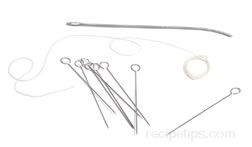A lard needle may consist of a single metal rod, similar to a sewing needle with a hole in the sharpened end that is used for threading a string through the meat that is tied securely to the end of a narrow strip of chilled fat. The strip of fat is then drawn into and through the meat, clipping off the string as it comes out the other side. A trussing needle may also be used for this purpose.
Another type of larding needle, also known as a lardoir, is a stainless steel oval shaft with a pointed tip that is attached to a wooden handle. The shaft is hollow and contains an injector tab to push contents held in the shaft out the opening of the pointed tip. The sharp tip is inserted into the flesh of meats to open a hole for the insertion of seasoned pork fat, chilled to make it more rigid. The fat is laid in the open shaft, which is then inserted into the meat and a metal injector tab can be freely pushed foward to inject the fat into the meat. As it comes out the other side, the larding strip is held firmly while the needle is removed. Depending on the cut of meat and how lean it may be, will determine how much basting and internal tenderizing is required with the strips of fat. However, as a general rule, strips of fat can be placed approximately 1-1/2 to 2 inches apart.
A technique similar to larding is barding - a process of laying strips of fat over the meat rather than inserting it into the flesh of the meat.










